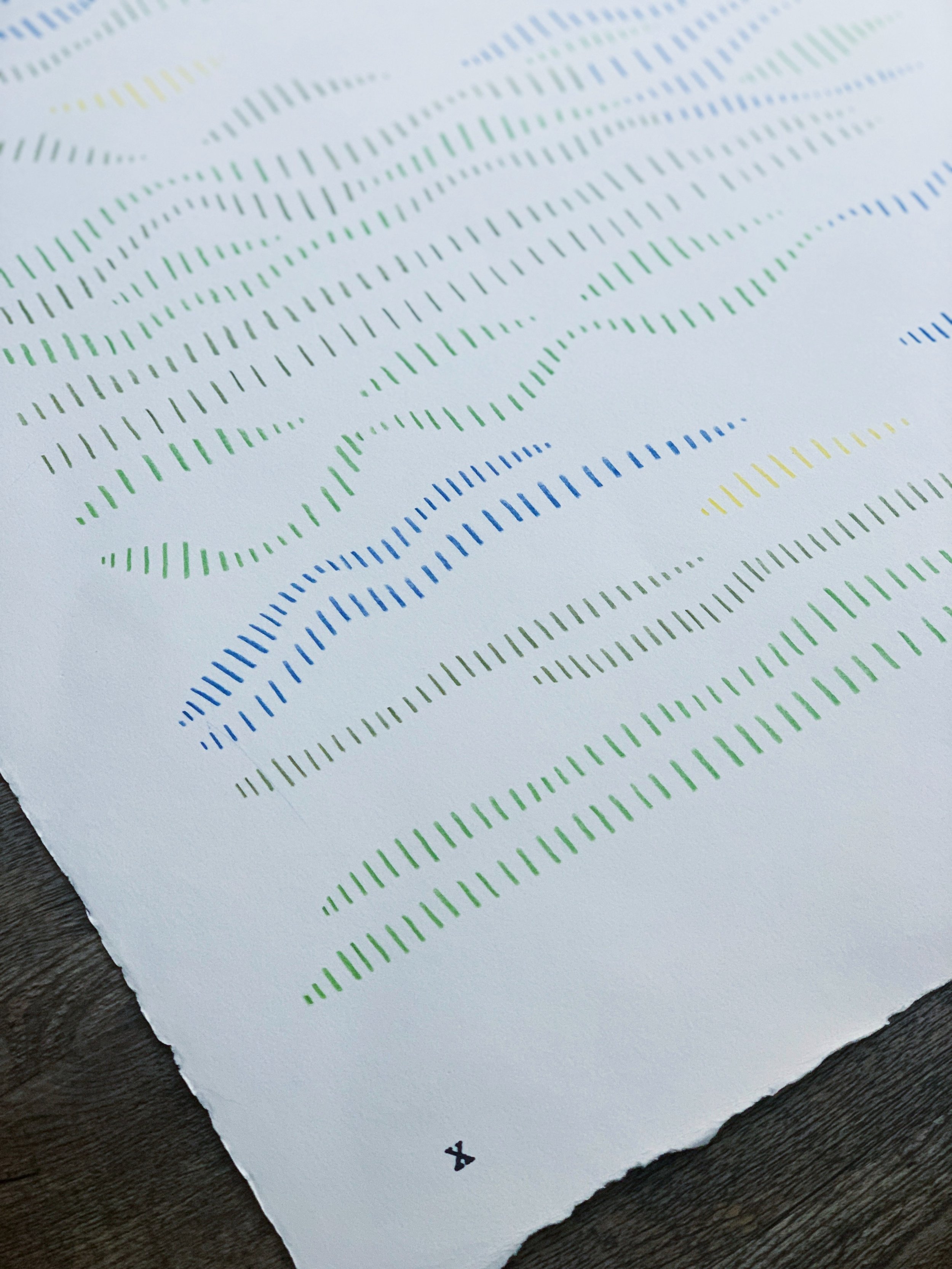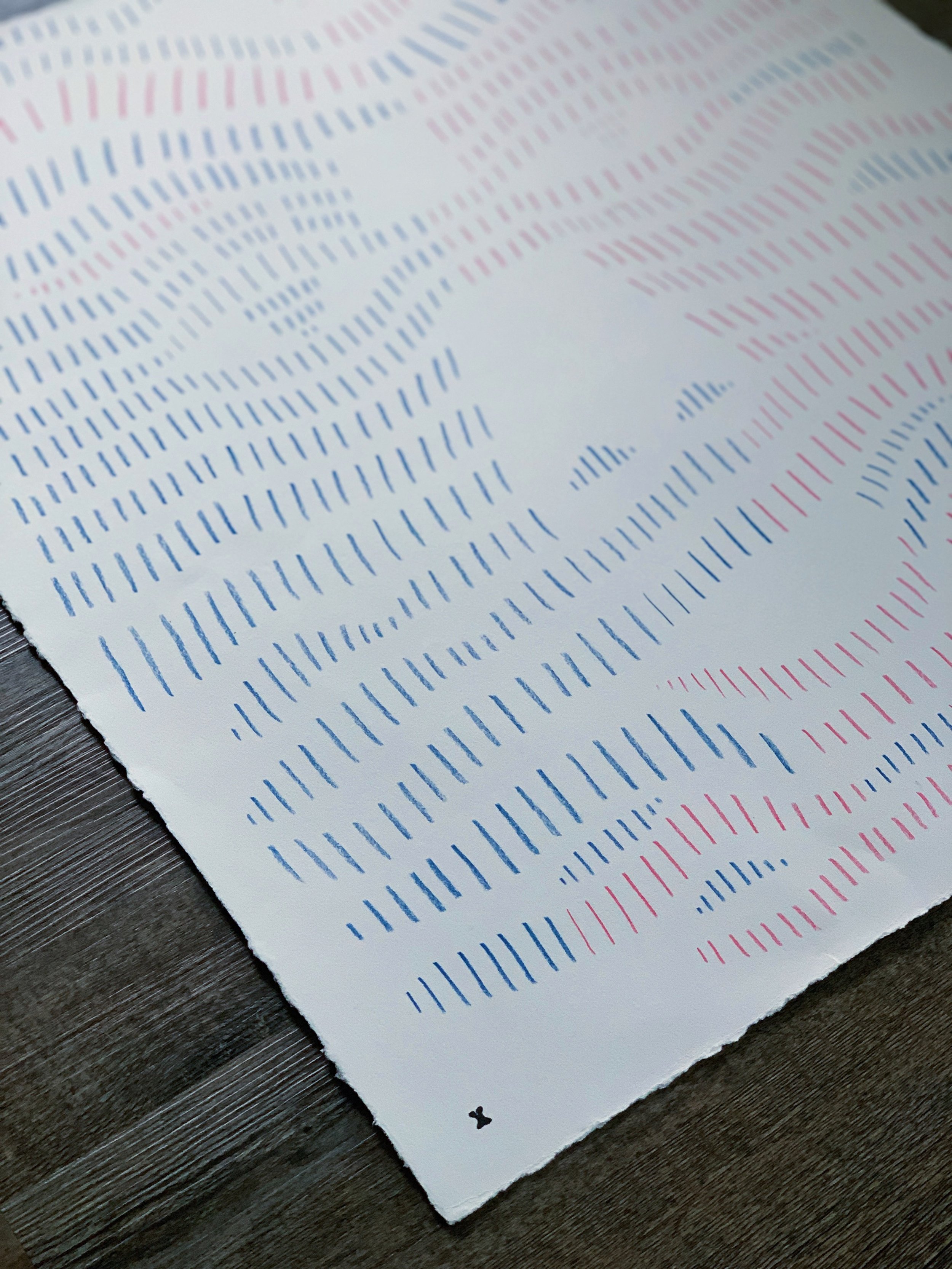By Becky Jensen for Pigment & Prose
In the frenetic ecosystem of contemporary art, where canvases are snapped up by collectors with the fervor of stock traders, Russell Brxwn stands as an enigmatic outlier, a painter whose work is as impossible to purchase as it is unforgettable to behold. At 41, this Austin-based artist has crafted a body of paintings that vibrate with the raw energy of pop culture and the serene discipline of meditative abstraction. Yet Brxwn’s true singularity lies not in his aesthetic but in his defiance of the market’s gravitational pull: he does not sell his original works. Not to billionaire patrons, not to blue-chip galleries, not to the most silver-tongued dealer. Instead, he donates his paintings to auctions for causes he holds dear—climate advocacy, youth arts programs, community resilience and gifts them to friends, fellow artists, and those who share his love for the arts. To own a Brxwn is to be anointed, not by wealth, but by proximity to his vision, a privilege that has made his work the art world’s most exquisite white whale.
Brxwn’s paintings are visual symphonies, built on what he calls “patterning lines” spontaneous, sinuous marks that cascade across his canvases like calligraphy unbound. These lines are both method and mantra, a way, he says, to “silence the overthinking mind and let the hand breathe.” In their fluidity, they evoke the gestural abandon of Cy Twombly or the rhythmic precision of Agnes Martin, yet their context is unmistakably contemporary. Brxwn weaves these lines through fragmented pop culture motifs abstract logos, graffiti scrawls, and the pixelated detritus of digital life, creating compositions that feel like snapshots of a city’s pulse.
To stand before a Brxwn painting is to feel caught in a paradox: the work is both a mirror of the viewer’s world and a window into the artist’s soul. His larger pieces, often stretching 10 feet or more, seem to pulse with life, their lines dancing in hypnotic rhythms that invite prolonged looking. Smaller works, no less potent, carry the intensity of a whispered confession. Yet for all their visual power, these paintings are not commodities. Brxwn’s refusal to sell is not a stunt but a philosophy, rooted in a conviction that art’s value lies in its ability to connect and uplift, not in its market price. “Paintings aren’t trophies,” he’s been quoted as saying, with the kind of disarming candor that makes you want to buy him a coffee and debate aesthetics till dawn. “They’re for sharing, for moving people, for changing things.”
“Cadillac Drive, 2024”
This ethos manifests most vividly in the auctions where Brxwn’s works occasionally surface, always tethered to causes that reflect his social and environmental commitments. Picture a bustling charity gala, the room abuzz with philanthropists and art-world insiders, when a Brxwn canvas is unveiled—a riot of cobalt lines swirling around a fractured, almost recognizable pop icon. The bidding erupts, not just for the painting’s beauty but for what it represents: a chance to support a youth arts initiative in Austin, a conservation effort in the Texas Hill Country, or a community center rebuilding after a storm. The sums fetched are staggering, yet Brxwn remains aloof from the frenzy, his focus fixed on the impact rather than the dollars. These moments are less transactions than rituals, cementing his paintings as objects of both desire and purpose.
Equally compelling are the stories of those who receive Brxwn’s gifts. A fellow artist might find a small canvas left unceremoniously at their studio, wrapped in butcher paper with a scrawled note: “Thought you’d get this.” A curator who championed his early work might open their door to a painting that captures the exact hue of a shared memory. An art lover who struck up a conversation at a dive bar might, months later, receive a work that feels like a continuation of that fleeting encounter. These gifts are not random but deliberate, bestowed on those who, in Brxwn’s estimation, understand art’s deeper currency. To be gifted a Brxwn is to be seen, to be invited into a quiet conspiracy of meaning-making. One recipient, a poet who met Brxwn at a late-night Austin open mic, described the experience as “like being handed a piece of his heartbeat, no strings attached.”
This refusal to commodify his work, places Brxwn in a rare lineage of artists who challenge the art world’s capitalist underpinnings—think of Marcel Duchamp’s subversive readymades or Banksy’s shredded auction stunt, though Brxwn’s approach is less confrontational than communal. His paintings, scattered across auction halls and the private walls of his chosen kin, are like rare manuscripts, their value amplified by their scarcity and the stories they carry. In an age when NFTs and seven-figure sales dominate headlines, Brxwn’s practice feels like a quiet revolution, a reminder that art can still be a gift, a gesture, and a catalyst for change.
"Adventures of Slaveman. 2024”
Yet there’s no sanctimony in Brxwn’s stance, no trace of the ascetic martyr. He’s as likely to be found sketching in an Austin taqueria, trading quips with strangers, as he is to be pondering the metaphysics of line in his studio. His work draws heavily on the city’s eclectic energy—its street art, its music scene, its blend of grit and idealism—infusing his paintings with a warmth that tempers their cerebral edge. He’s a magpie of pop culture, plucking references from vintage album covers, comic book panels, and the glitchy aesthetics of early internet memes, then reweaving them into something that feels both nostalgic and prophetic. A Brxwn painting might remind you of the first time you saw a Keith Haring mural or the last time you scrolled through a feed at 2 a.m., yet it never feels derivative. It’s as if he’s distilled the noise of the world into a single, resonant note.
The art world, of course, is not immune to the irony of Brxwn’s inaccessibility. Collectors whisper about him in the hushed tones reserved for urban legends, trading rumors of who might have snagged one of his works at a recent auction or through a stroke of personal luck. Gallerists, ever hopeful, float proposals for shows that might coax him into the market, only to be met with a polite but firm demurral. Critics, meanwhile, grapple with how to evaluate an artist whose output resists traditional metrics of success. Is Brxwn a visionary or a provocateur? A saint or a strategist? The truth, as always, lies in the work itself—paintings that demand to be experienced, not owned, and that linger in the mind like a melody you can’t quite place.
For now, Brxwn remains in Austin, painting with the same restless curiosity that has defined his career. His studio, by all accounts, is a chaos of half-finished canvases, vinyl records, and dog-eared books on everything from Buddhist philosophy to streetwear history. He’s at work on a new series, though he’s characteristically coy about its details, hinting only that it involves “lines that move like water.” Whether these paintings will end up in a charity auction, a friend’s living room, or some other unexpected corner of the world is anyone’s guess. What’s certain is that they’ll carry the same alchemy that defines all of Brxwn’s work: a blend of heart, hustle, and a stubborn belief that art can still change the rules of the game.
As I write this, I can’t help but imagine stumbling across a Brxwn painting someday, perhaps in a community center or on the wall of a friend who earned his trust over late-night tacos. It would be a moment of recognition, a reminder that the best art isn’t the kind you buy but the kind that finds you. In a world obsessed with possession, Russell Brxwn is painting a different kind of legacy one line, one gift, one cause at a time.
Resources
www.brxwnsville.com
instagram.com/brxwnsville

























































































